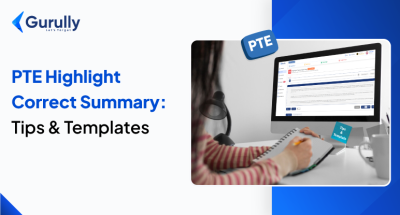Listening in the PTE exam is not only about “hearing; it is about catching details, comprehending statements, managing time, and answering accurately. And it gets more difficult if you are unfamiliar with English. So, to attempt the task confidently, you need the right strategies and constant practice. Here are highly efficient PTE tips and tricks for listening that will help you score high.
Let’s start with a brief overview of the PTE listening section:
In this section, you must attempt eight tasks in PTE Academic and 7 tasks in PTE Core. The PTE listening section tasks are based on audio or video clips. You have to hear those clips or see videos and then respond accurately. The listening section lasts 30-43 minutes and you can hear the audio only once.
| Task | No. Of Questions |
| Summaries Spoken Text | 1-2 |
| Multiple Choice, Multiple Answers | 1-2 |
| Fill in the Blanks | 2-3 |
| Highlight Correct Summary | 1-2 |
| Multiple Choice, Single Answer | 1-2 |
| Select Missing Word | 1-2 |
| Highlight Incorrect Words | 2-3 |
| Write from Dictation | 3-4 |
PTE Tips and Tricks for Listening
Prioritize the High-Scoring Tasks
Not all tasks carry equal weight, so prioritize practicing high weightage questions.
Tip: Practice these individual question types in free on Gurully or here PTE Listening Practice.
Train Your Ears for Accents
- Don’t rely only on American English! The PTE includes speakers from the UK, Australia, and New Zealand. If you are unfamiliar with these accents, you might miss simple words.
Trick: Watch YouTube interviews, podcasts, or news from different countries. TED Talks are great, too. Treat them like practice—not passive entertainment.
For “Write from Dictation” – Focus on Accuracy Over Speed
This task is simple but you can loose scores if you are not careful. It’s not just about catching words—it’s about:
- Spelling every word right (PTE Vocabulary Guide)
- Using correct punctuation
- Keeping word order accurate (Most Repeated Questions)
Tip: Practice typing without looking at your keyboard. Use dictation apps or record your own sentences and replay them for practice.
Learn to Skim and Predict
- For “Summarize Spoken Text” and “Highlight Summary,” you need more than just memory. Try to grasp the main idea quickly.
Trick: While listening, jot down keywords, but don’t write entire sentences. Use abbreviations to form a clear and coherent summary. For example:
- Econ drop – US market fell, investors fear
- Speaker mentions gov response + inflation rise
Use the Erasable Notepad Wisely
You’re allowed to take notes. Use them smartly. Don’t write everything else you will waste time.
Trick: Develop your own system for notes. Use arrows for causes/results, caps for names, and symbols for connections. For example:
| Spoken Content | Smart Note-Taking Example | Explanation |
| “The industrial revolution began in Britain due to several economic factors.” | IND REV → Britain b/c $ factors | Use abbreviation (→ for result, b/c for “because”) |
| “Einstein’s theory of relativity changed the way we view space and time.” | EINSTEIN: Relativity → new view on space/time | CAPS for names, arrows for impact |
| “Photosynthesis converts light energy into chemical energy in plants.” | PhotoSYN: light → chem E (plants) | Shorten words, use scientific symbols like E = energy |
| “Climate change is primarily caused by greenhouse gas emissions.” | Climate ∆ ← GHG ↑ | Use ∆ for change, ↑ for increase |
| “Newton discovered gravity when an apple fell from a tree.” | NEWTON: apple fall → gravity | Simple cause-result visual |
| “The Great Depression affected global economies in the 1930s.” | GR8 DEPR: global econ hit (1930s) | Use slang-like abbreviations (GR8 DEPR = Great Depression) |
| “Water boils at 100 degrees Celsius under standard pressure.” | H₂O boil = 100°C @ std press | Use chemical formulas, symbols, and units |
| “Shakespeare wrote many tragedies including Hamlet and Macbeth.” | SHAKESPEARE → tragedies: Hamlet, Macbeth | Group info using colons and commas |
| “Deforestation leads to loss of biodiversity and climate imbalance.” | Deforest → ↓ biodiversity + ∆ climate | Use ↓ for decrease, + for “and”, ∆ for “change”
|
| “Vaccinations help prevent the spread of infectious diseases.” | Vaccines → stop spread (infect dis) | Bracket extra info, use action verb “stop” |
Be Ready for Distractions
- PTE audios are designed with natural speech—hesitations, false starts, fillers like “um” or “you know.” Don’t get confused about it.
Tip: Don’t wait for the speaker to be perfect. Focus on meaning, not how they’re saying it.
Don’t Let One Task Affect the Next
- Even if you mess up one audio, do not panic and move on to next question.
Tip: If you’re unsure, make your best guess. There’s no negative marking (except in a few multiple-choice ones). Don’t leave blanks.
Practice Under Real Test Conditions
- Most people practice listening in quiet, calm environments. But the test center may be noisy, and the pressure is real.
Trick: Simulate real test conditions. Set a timer. Play back-to-back audio clips. You can also practice on Gurully’s full-length PTE mock test.
Scoring Pattern In PTE Listening Section
Understanding scoring is equally essential to learning tips and tricks for PTE listening. So here is a detailed guide:
| Task | Scoring Type | Skills Scored | How It is Scored |
| Summarize spoken text | Partial credit | Listening & Writing | Content: 2 = good summary, all key points; 1 = fair summary, 1–2 points missing; 0 = key points missing/wrong Form: 2 = 50–70 words; 1 = 40–49 or 71–100 words; 0 = <40 or >100, all caps, bullet points, no punctuation Grammar: 2 = correct; 1 = some errors, meaning clear; 0 = major grammar issues Vocabulary: 2 = good word choice; 1 = some wrong words, meaning clear; 0 = wrong words affect meaning Spelling: 2 = correct; 1 = 1 error; 0 = more than 1 error |
| Multiple-choice, choose multiple answers | Partial credit | Listening |
1 = correct option; 0 = incorrect |
| Fill in the blanks | Partial credit | Listening & Writing | 1 = correct option; 0 = incorrect |
| Highlight correct summary | Correct/Incorrect | Listening & Reading | 1 = correct option; 0 = incorrect |
| Multiple-choice, choose single answer | Correct/Incorrect | Listening | 1 = correct option; 0 = incorrect |
| Select missing word | Correct/Incorrect | Listening | 1 = correct; 0 = incorrect |
| Highlight incorrect words | Partial credit | Listening & Reading | +1 per correctly selected incorrect word; -1 per wrong selection |
| Write from dictation | Partial credit | Listening & Writing | +1 per correct word; 0 = wrong or misspelled words |
Preparation Plan for the PTE Listening Section
A well-structured preparation plan is essential for consistent progress. Here’s a four-week plan tailored for focused listening practice:
Week 1: Build the Basics
- Familiarize yourself with all eight question types.
- Start listening to English audio daily (podcasts, news, interviews).
- Practice summarizing short talks in 2-3 sentences.
- Dictation practice: Write down 5–10 sentences daily.
Week 2: Focused Practice
- Take mock tests for each question type individually.
- Start using Gurully.com or the official PTE practice app.
- Begin timing your responses.
- Review mistakes and learn from answer explanations.
Week 3: Strategy and Speed
- Practice combining note-taking and listening efficiently.
- Focus on Filling in the blanks and Writing from the dictation (high-weight tasks).
- Practice identifying filler words, emphasis, and changes in speaker attitude.
Week 4: Full-Length Practice
- Take 3–4 full Listening section tests.
- Review time management.
- Identify your weakest question types and revise your strategy accordingly.
- Analyze patterns in your errors.
While these PTE listening tips and tricks are helpful, they’re only part of the journey. To truly aim for a high score, consistent practice is key. That’s where Gurully comes in. We offer full-length PTE mock tests with instant AI scoring to track your progress. Our real-time exam simulation gives you the feel of the actual test environment, helping reduce exam-day anxiety. Make the most of our section-wise tests and free, question-wise practice to sharpen your skills and boost your listening score with confidence.
Conclusion:
Scoring well in the PTE listening section takes more than just understanding English. You need to focus on keywords, manage time smartly, and apply targeted strategies. The tips and tricks for PTE listening shared above, along with regular mock tests, helps in building real exam confidence. If you’re looking for how to improve listening skills for PTE, consistent practice on Gurully can make a big difference. Use these PTE tips and tricks for listening to boost your performance.
FAQ
How to Get a Good Score in PTE Listening?
How to Score 79 in PTE Listening?
How to Improve Listening Skills?
How to Practice Active Listening?
How to Pass a Listening Test?
Also Read:
- PTE Table Chart: Tips, Template & Sample Questions with Answers to Score High
- PTE Academic Describe Image: Tips, Types, and Sample Question with Answers
- Know Everything About PTE Rescore Success Rate, Appeal, and Technical Review Policies
Useful Pages for PTE Test Takers







